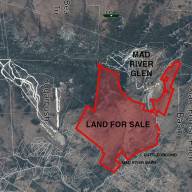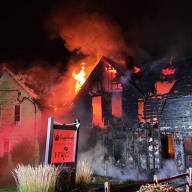This should be fun. The tri-town conservation commissions’ work to manage invasives, including knotweed, is getting some four-legged help from goats this summer. Adding goats to the mix of tools used by the Warren, Fayston and Waitsfield Conservation Commissions’ efforts will help manage larger more complex knotweed infestations, especially in harder-to-reach stands along the Mad River and its tributaries, according to Warren Conservation Commission chair Jito Coleman.
Using grazing goats to manage invasives hasn’t been tried in The Valley but it is used extensively around the world to control herbaceous invasives including knotweed and there are active goat-scaping programs ongoing in New York, Massachusetts, Rhode Island, and New Hampshire,” Coleman explained.
“‘Goat-scaping’ breaks the regrowth cycle of knotweed and other invasive plants without the use of toxic herbicides and because the goat digestive process, effectively sterilizes seeds and reproductive plant matter, goats are used. Our goal is to create a viable, sustainable, successful business model in the Mad River Valley that could be the blueprint for a new agricultural opportunity benefitting both Vermont farmers and the Vermont riparian environment,” he said.
Coleman explained that the tri-town goat-grazing effort is just one of several other major new initiatives. In addition to the goats, he said, this summer’s work will include:
- A program to decontaminate roadside gravel infested with knotweed modeled after a successful French program.
- Expanding the GIS mapping and measurement database of all managed sites to quantify the most successful restoration techniques.
- Dramatically expanding native plantings in riparian regions along the river.
“The Tri-Town Conservation Commissions are continuing the important work of restoring our environment by managing invasive species in The Valley. This year we are expanding the scope and scientific depth of our work by collaborating with UVM. After four years of hiring summer interns from the Rubenstein School at UVM, we are now adding professors and a graduate student with expertise in invasive species and restoration ecology from UVM’s Field Naturalist Masters Program and the newly formed Ecological Planning Laboratory. This expertise and experience will help us better qualify and quantify management of the more than 250 knotweed infestations around The Valley and the remediation efforts deployed to that end,” Coleman explained.
Some of this summer’s work falls within the scope of a two-year Lake Champlain Basin Program $100,000 grant which was received this winter. Other parts of the summer’s efforts do not fall under the grant and require alternative fundraising.
The grant will be used to clean up knotweed propagules spread by the December 2023 flood in 10 flood plain locations and increase the number of knotweed infestations being managed from 145 in 2023 to 175 in 2024/2025; plant 1,272 bare root native trees and shrubs in five high-priority riparian locations along the Mad River where knotweed is being managed, contributing to the restoration of riparian ecosystems; implement a scientifically-grounded monitoring program to gauge the effectiveness of knotweed management methods; conduct an initial assessment of the locations and prevalence of invasive species other than knotweed to help inform the next phase of work and develop plans/priorities for management; increase community awareness of the damage caused by invasive plant species and actions that can be taken to minimize this damage.
“We have secured some funding from The Valley towns, but our expanded efforts are still not fully funded. We are asking people to consider a contribution to help fund our invasive species management initiatives. Our goal is to raise $50,000. Currently, we have $22,000 pledged to this funding effort. We are hoping residents and local businesses can contribute to help us meet our goals,” Coleman added.
Friends of the Mad River, a member-supported 501(c)(3) nonprofit organization dedicated to stewarding the Mad River Valley’s land and clean water, has agreed to be the financial agent for this fundraising effort to help support the tri-town conservation commission work on managing invasives. Funds collected will be managed by FMR in conjunction with the Tri-Town Conservation Commissioners.
Here is the QR code for those who’d like to donate via the Friends of the Mad River website:
Donors should specify that the donation is for Invasives in the "Write a note" section when making their donation online or in the memo section if making a donation by check.













